I arrived at the Kashgar bus station before dawn, and briefly looked outside the station. The only people up and about were the odd taxi driver and the morning street sweepers. I went back inside to check the schedules to Tashkurgan, and decided that since I was already up and at the bus station, I might as well immediately take the bus there.
 |
| The bus stops in Upal for breakfast, where I bought some naan and took a picture of the tandoor in which they (and samsas) are cooked. The baker will periodically season the inside of the tandoor by throwing fistfuls of salty water against the interior, which sizzles and leaves the salt coating on the interior. Sometimes you get a chunk of salt on the bottom of your naan. Apparently the government is giving incentives to have bakers switch to electric tandoors, instead of these inefficient coal-fired ovens. |
 |
| I had an aisle seat, so I wasn't able to take pictures through the window, and could only take pictures when we stopped. This is at the checkpoint at the head of the Ghez river. The Ghez river valley is a wide, stony plain that fills with melt water in the spring and summer, lined with mountains that range from grey to deep red. |
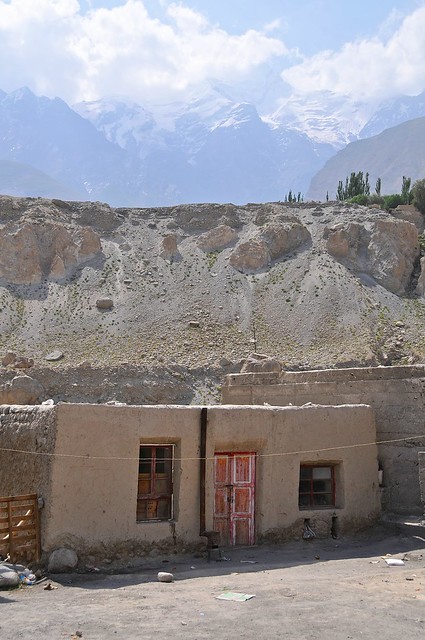 |
| Dusty shopfront at the checkpoint. |
After the checkpoint the road becomes steeper, and we do most of our climbing. At the end of the climb we arrive on a broad mountain valley—or pamir—at an altitude of about 3,500 meters. The first thing you see on entering the pamir is Bulungkol lake whose opposite shores are formed by sand-dune mountains.
After the sand-dune mountains, the next major place of interest is Karakul lake. The bus will stop here, since it is a major tourist destination, and a few people will get off and maybe someone will get on. I was able to run away and take some pictures while we stopped, but the driver was annoyed because I ended up being the last one back on board and he had to wait a couple of minutes for me.
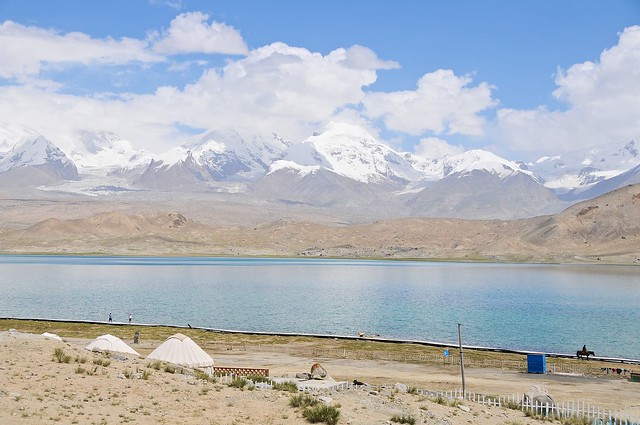 |
| Tourist yurts on the shores of Lake Karakul, elevation 3,600 meters. |
 |
| Looking south over the silty, aquamarine lake. |
 |
| A camel-herder bringing camels to the tourist area for rides. |
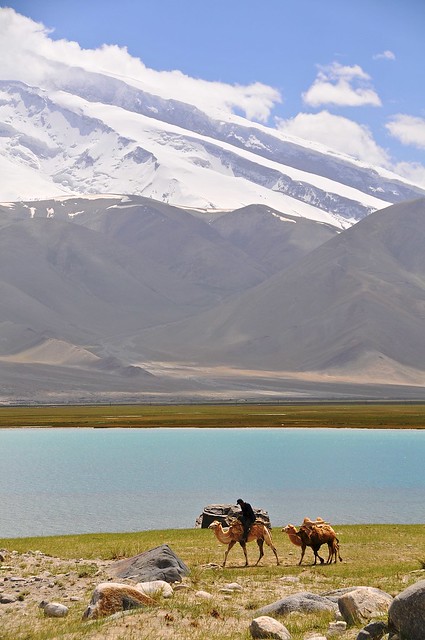 |
| The slopes in the background are that of Muztagh Ata, elevation 7,546 meters. |
 |
| Two-humped Bactrian camels. |
 |
| The Kongur Shan mountains in the background are even higher than Muztagh Ata, as Konghur Tagh tops out at 7,649 meters. |
 |
| At another checkpoint past Karakul lake they again do a brief check of our papers. It used to be you needed a permit to go to Tashkurgan; now you only need a permit of going past Tashurgan and up to the border point. |
The bus dropped us off at the Tashkurgan bus station, which was little more than a dirt parking lot behind a building. I joined up with a Korean guy, Baek, who was on the bus with me and we looked for a place to stay. Although he had been in China for about the same amount of time as me, he spoke enough Chinese to book rooms and buy train and tickets, while I basically spoke no Chinese. It's not like Korean is a tonal language, either, so I really don't have any excuses. I'm really bad with foreign languages, mainly because I'm so insecure that I don't want to make a fool out of myself by speaking badly. It's a real weakness.
Anyway, the transport hotel wanted to charge 120 per person, and it was really difficult to find anywhere that was both cheap and could take foreigners. Baek decided to go into one of the expensive places, the
Crown Inn, and ask if they knew anywhere. I wouldn't have done this, but it really paid off, as the English-speaking manager told us the location of a nearby hostel that had recently opened, though she didn't know if they would accept foreigners.
This was the 37° North hostel, run by a young Han girl. It had clean bathrooms and a mix of rooms. The dorm was a large empty room in which you slept on the floor, so Baek and I split a double room with proper beds. We then set out to explore the town. On the east side of town is the main valley pasture and river, with lots of Kyrgyz yurts, livestock, and Tajik families. There's also a nice park with boradwalks and gazebos that jut out onto the grassland, and an amphitheater in which they often have traditional dancing performances (they were supposed to that night, but they were cancelled). An old stone fort (which was apparently used in the filming of
The Kite Runner) is also on the western edge of town, and it was the only place in China where I saw a Japanese tour bus. Tickets to the stone fort were 30 yuan, and apparently there wasn't much to see inside, so we skipped it. There were guards all around the fort to prevent people from entering from other entrances, too.
 |
| Tajik girl and her cow. The cow knows who the boss is. Many of the Tajiks in China wear bright red, sequined dresses, which is not something you really see in Tajikistan. Also, most of the people living in adjacent areas of Tajikistan (around Murghab, essentially) are ethnic Kyrgyz, which makes the ethnography of the non-Han in the Tashkurgan Tajik Autonomous County relatively puzzling—for the most part they look Tajik, even if they live in Kyrgyz yurts. |
As we ventured out into the grasslands we met a Han Chinese photographer who had been staying in Tashkurgan for a week or so, and he offered to accompany us around the valley.
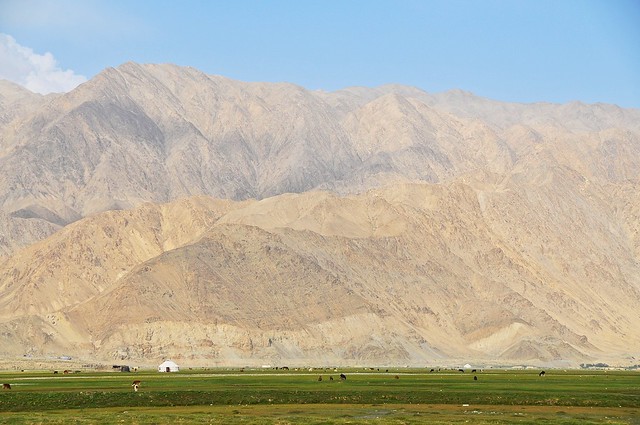 |
| The valley grasslands looking east from Tashkurgan town. |
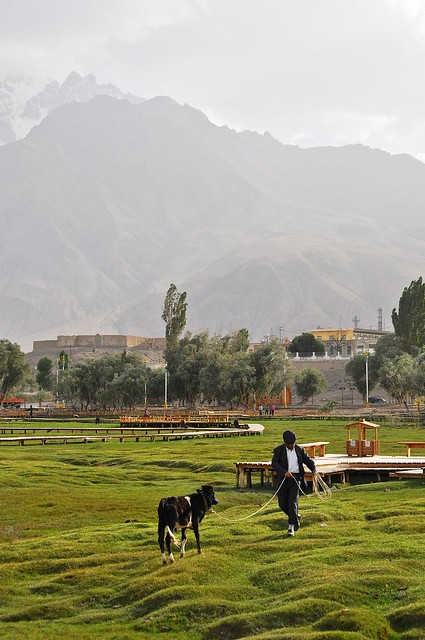 |
| The fort in the upper left background, the boardwalk, and a Tajik herder collecting his cow for the night. |
 |
| For the most part the animals are free-range, and not staked down, however. |
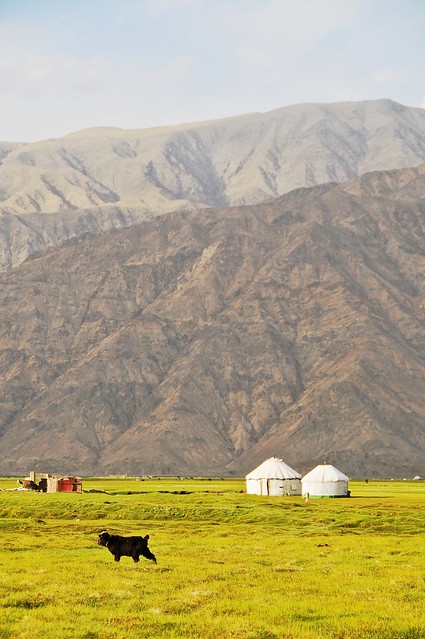 |
| Kyrgyz yurts on the plain. |
 |
| A woman observes us from outside her yurt. |
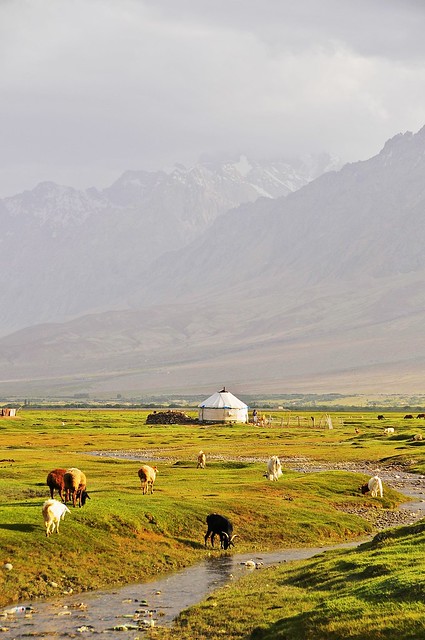 |
| Looking south along the valley. There are numerous little rivulets meandering through the valley |
 |
| A couple of goats still bearing traces of their winter coats, which they'll soon have to start growing again. |
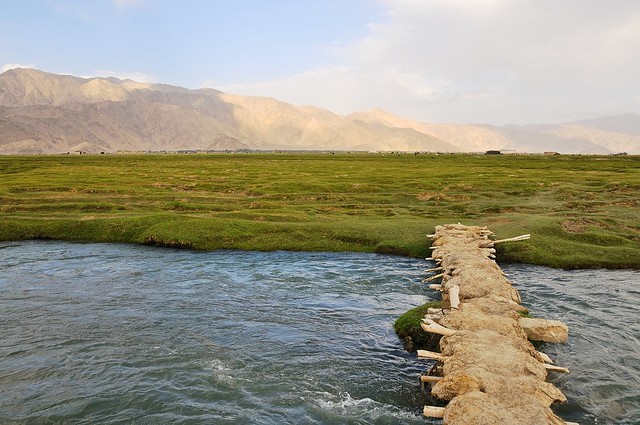 |
| Rickety bridge over a larger stream. |
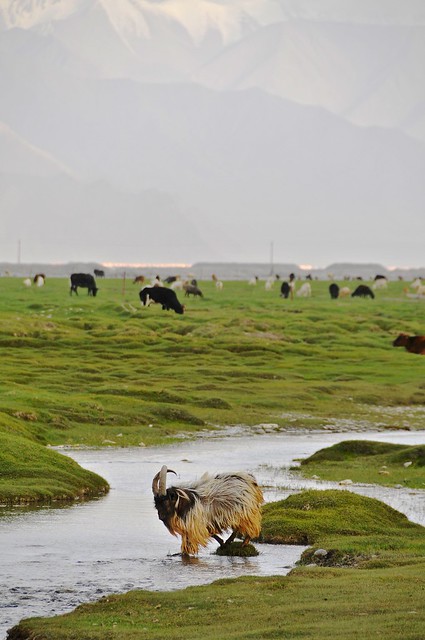 |
| An impressive set of horns. |
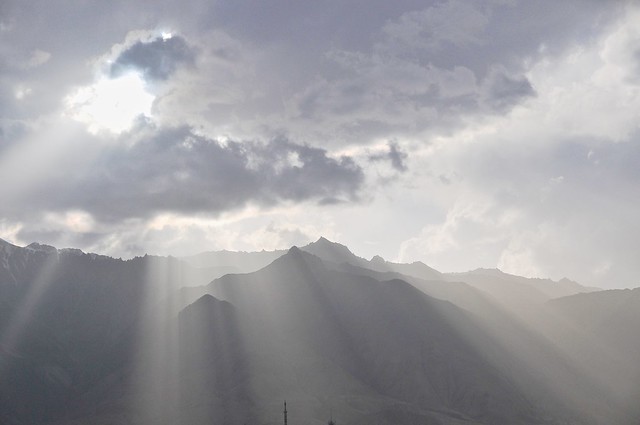 |
| The evening sun through the clouds. |
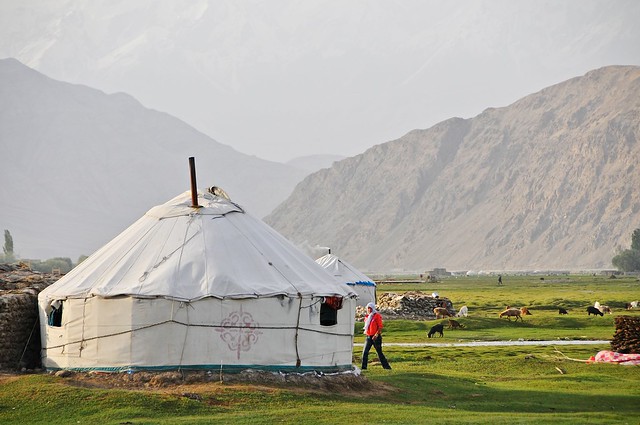 |
| The Han guy basically invited himself and us into this yurt. I was very uncomfortable at him insinuating us into the situation, and treating them like some sort of human zoo exhibits, as the Chinese guy talked about them. Though they were certainly friendly, I think they hoped for a bit of money, but I could be very wrong from what I later saw of Tajik and Kyrgyz hospitality. |
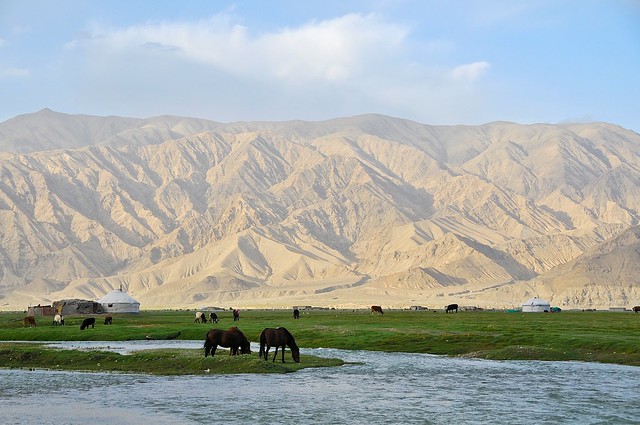 |
| Horses are relatively uncommon—at least in comparison to Mongolia. |
 |
| The stone fort of Tashkurgan, which may be a little redundant (Tashkuragn itself means "stone fort"). |
 |
| A tomb on a hill in Tashkurgan. |
 |
| There were lots of tombs on the high, rocky, marginal land in Tashkurgan. |
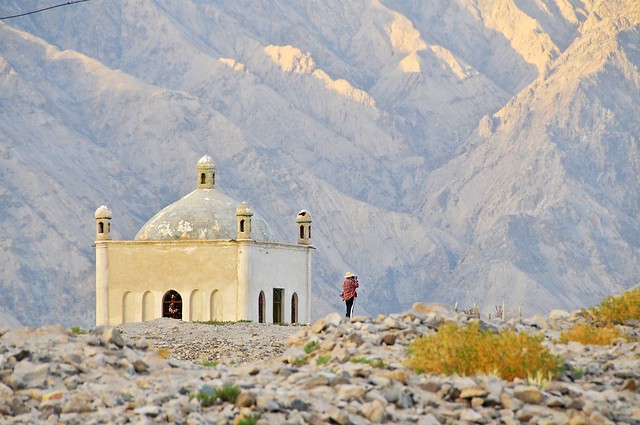 |
| A Chinese tourist takes in the views. We didn't see that many other tourists in the area. |
 |
| Surprising fields of grass or grain. |
 |
| In the 'stans, most Kyrgyz are nomadic herders, while the Uzbeks and Tajiks are sedentary and tend to be either exclusive farmers or mix farming with animal husbandry. It's unusual to see both nomadic yurts and cultivated fields being operated by the same ethnic group. |
 |
| The mountains east of the valley. |
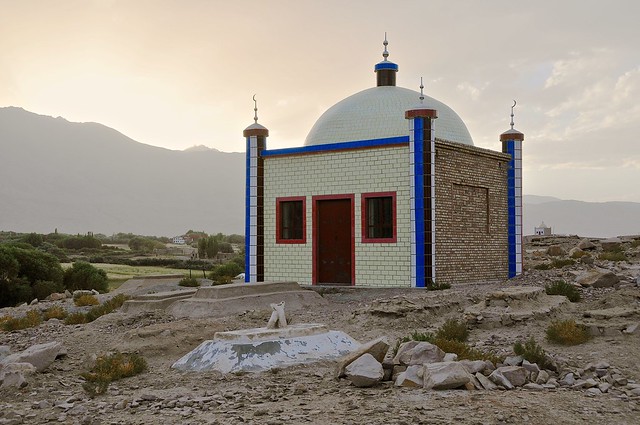 |
| A modern tomb and graves. |
 |
| Home for the night: 37° North hostel in the setting sun. Behind the wall it opens up into a nice garden before the toilet area and main building. |
When we got back to the hostel there was another foreigner who had arrived: a Scottish cyclist who had come in from Kyrgyzstan, stopped briefly in Kashgar, and who was now on his way to Pakistan. He was the first cyclist I would meet, but it turns out that Central Asia is filthy with cyclists, most of whom are going from Europe to China.
He shared some stories about Central Asia, between hitting on the Chinese manager, who thought he looked like Carlos Puyol. He said that everyone in Central Asia thought he looked like Puyol, but I said he reminded me of someone else. After I moment of thinking, I realized that someone else was actually Carlos Puyol.
The Chinese girl said we would have to leave the hostel until 11:00 pm, as there was a good chance the police would visit and if she was caught allowing foreigners to stay she would get a big fine. I was feeling a bit sick that day and would prefer to go to sleep or rest quietly, so it wasn't great me, but we went out to a restaurant and I had a soda while the others ate.
Baek was also leaving to Pakistan the next day—although the international bus leaves from Kashgar, it overnights in Tashkurgan and you can catch it in the morning from around the customs office (about 3 km up the KKH from Tashkurgan) if you get there around 9 or 10. I think the North-West Frontier Province of Pakistan would have been amazing to visit, but apparently it can be difficult to get a Pakistani visa from China.
 |
| The main east-west street in Tashkurgan. The bus station is at the end of the street, just before the intersection with the KKH, on the left. Those cars parked on the left are available as share taxis. |
I ended up sleeping in, but waking up feeling much better. Since I had missed the bus back to Kashgar, I walked around exploring the town. One thing I noticed was that all the supermarkets had bulk bins of little snacks and sweets, which was unusual for China (but is very common in the former Soviet states), so I bought a selection to try them.
I then wandered around town for a while and found a share taxi back to Kashgar for 100 yuan. A bit on the pricey side, at almost double the bus fare, but much quicker.
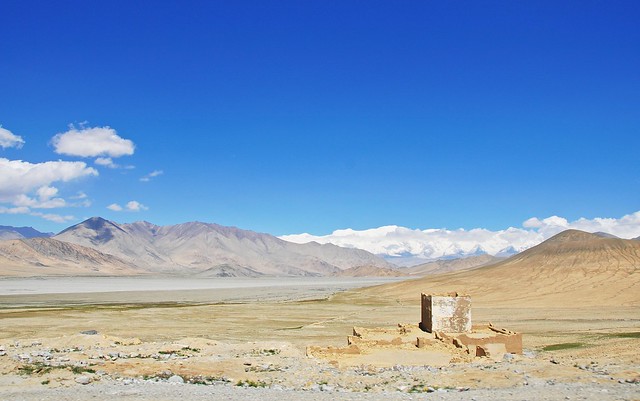 |
| Ruins as we come down from a small range of mountains into the valley or pamir where Karakul is, with the Kongur Shan mountains in the distance. |
 |
| Muztagh Ata from the highway. |
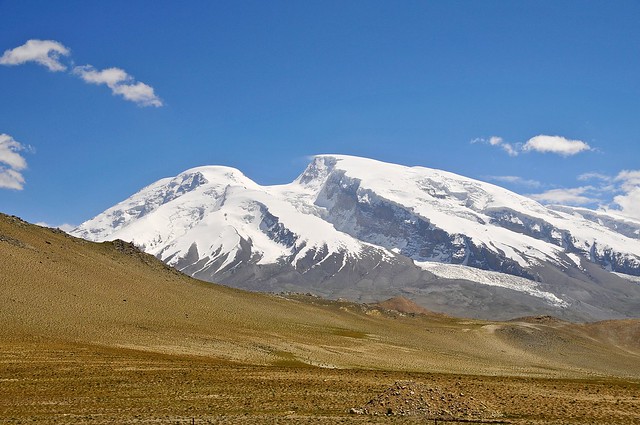 |
| It hardly looks like a 7,000 meter mountain (almost 900 meters higher than the highest mountain in North America, McKinley). |
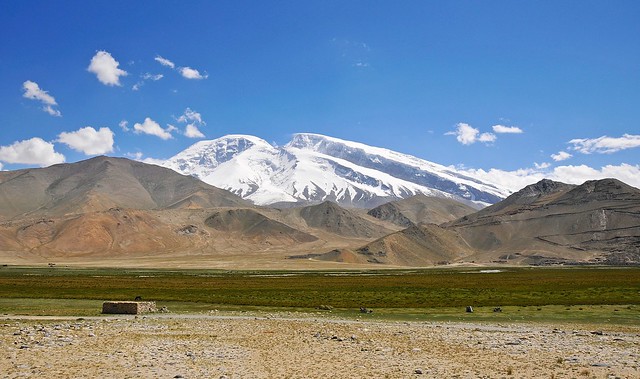 |
| Ruins, lush green valleys, snow-capped peaks... pretty amazing. |
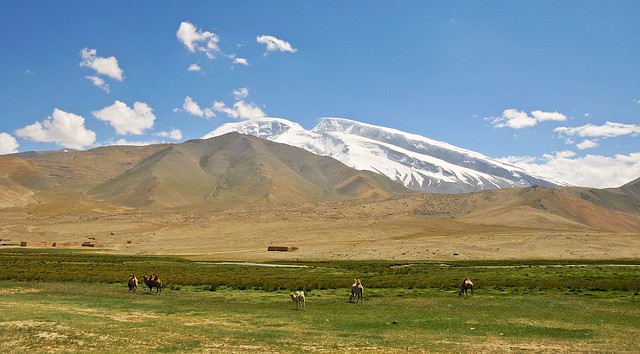 |
| Bactrian camels graze by the road. I imagine they don't like the winters that much. |
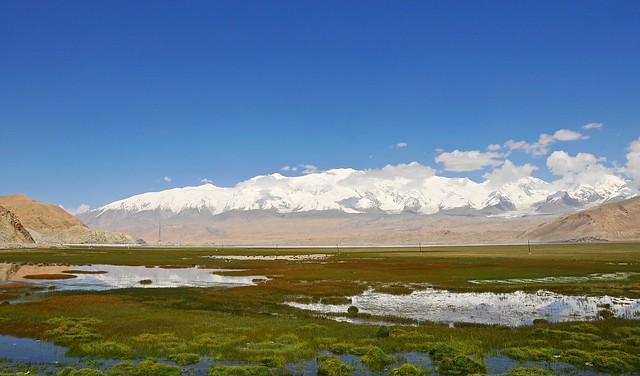 |
| The Kongur Shan mountains look even less imposing than Muztagh Ata, despite being higher. |
 |
| A rare donkey. Not much seen in china, but quite common in the 'stans. |
 |
| We made a brief stop at Karakul, which seems like an inapposite name for this lake ("black lake"). |
 |
| Tourist yurts by the lake. |
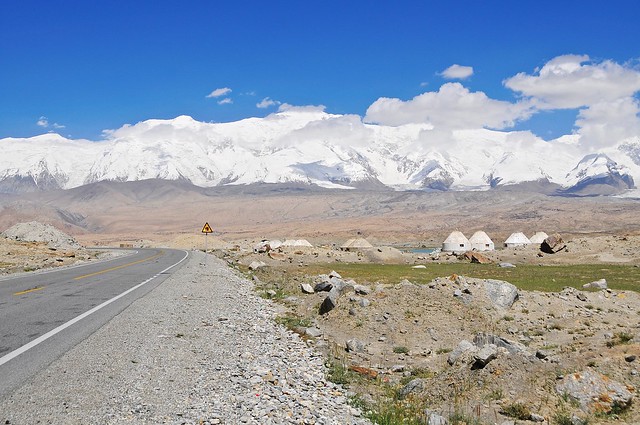 |
| The mountains look more imposing as we get closer, but still nothing special. Chinese-made concrete yurts can be seen on the right. Stay there and you also have to pay for a tourist entrance ticket to use their wonderful facilities and parking lot! |
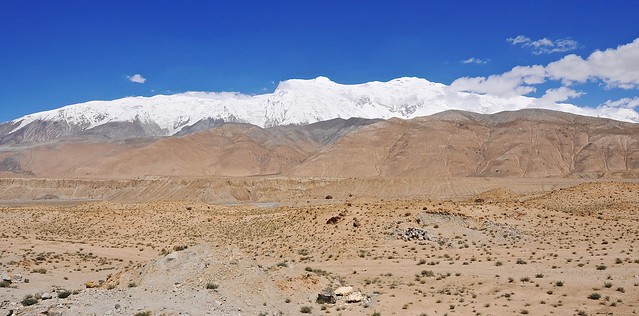 |
| The grassy pastures are no more, and have been replaced by rocky scrub. |
 |
| The riverbeds carry more water, which sweeps away any soil that would support any vegetation. |
 |
| A rare patch of greenery, as the river widens and the river slows. |
 |
| We sped along at well more than 60 km/h. |
 |
| I was in the passenger seat and the car had really bad window tinting, so it was basically useless to try and take pictures through the windows. Unfortunately, you could only really see Bulungkol through the left side. |
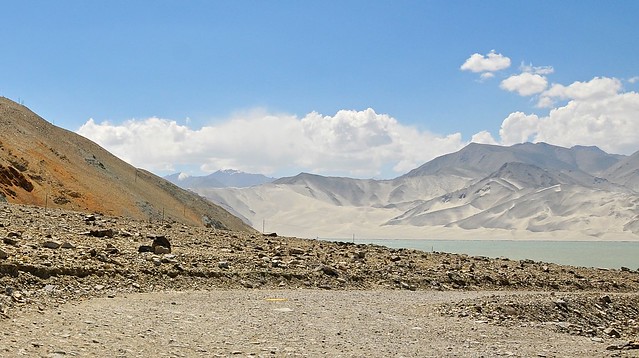 |
| Bulungkol lake, as obtained by sticking the lens of my camera out of the narrow aperture my window would open, and blindly shooting backwards. |
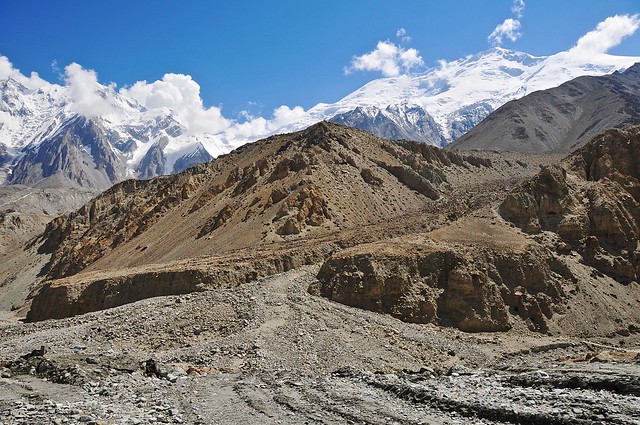 |
| In the spring this valley must see torrential melt waters. |
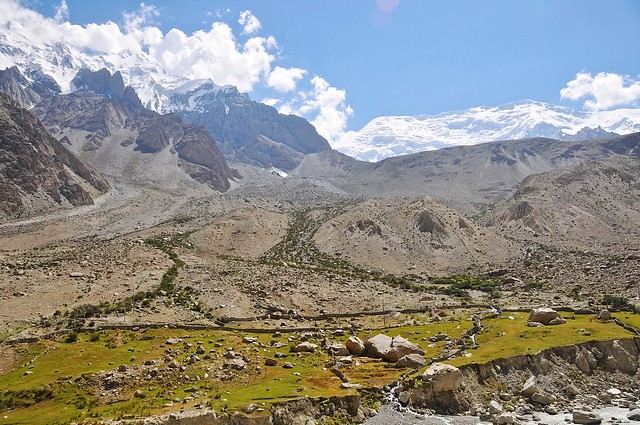 |
| Tiny patches of vegetation are the best you can hope for. |
 |
| I'm surprised there are electrical poles in the middle of the riverbed, and that they survive even one spring runoff. |
 |
| Surprisingly, the road bore evidence of a washout only in one spot. |
 |
| At the police checkpoint, with all the vendors open. |
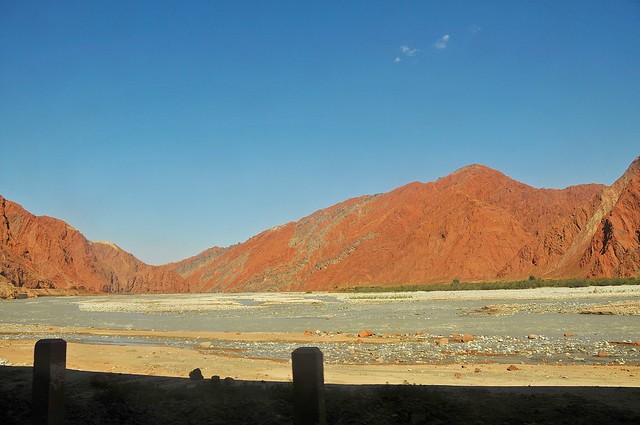 |
| After the checkpoint you pass through a flat section of the Gaizi river valley, lined with bright red mountains. |
Unfortunately, the taxi didn't take us all the way into town, but dropped us on the outskirts of Kashgar along a main boulevard. I had no idea where we were, but got on a bus on the theory it would take us to the middle of town, and in fact it took us right next to the Id Kah mosque, which was where the Pamir Hostel was (I had been warned off the Old City hostel, as apparently they had stopped accepting foreigners within the past week, after being caught without a permit and being fined).
Budget
August 24, 2012, in Tashkurgan: 117 yuan
- 37° North hostel: 55 yuan for shared double
- Bus to Tashkurgan: 52 yuan
- 2 sodas and 2 naan: 10 yuan
August 25, from Tashkurgan to Kashgar: 196 yuan
- Pamir hostel: 50 yuan for dorm with bathroom but no AC
- Share taxi to Kashgar: 100 yuan
- Bulk snacks: 17 yuan.
- Drinks: 15 yuan
- Dinner: 10 yuan
- Fruit: 4 yuan























































This sounds like an incredible journey!
ReplyDelete